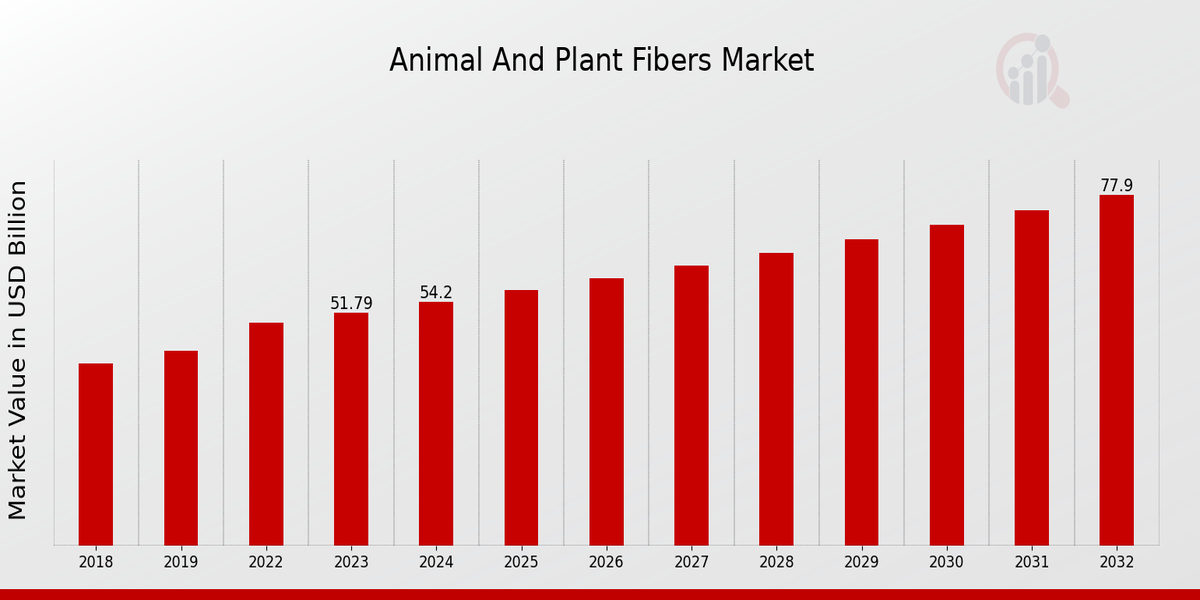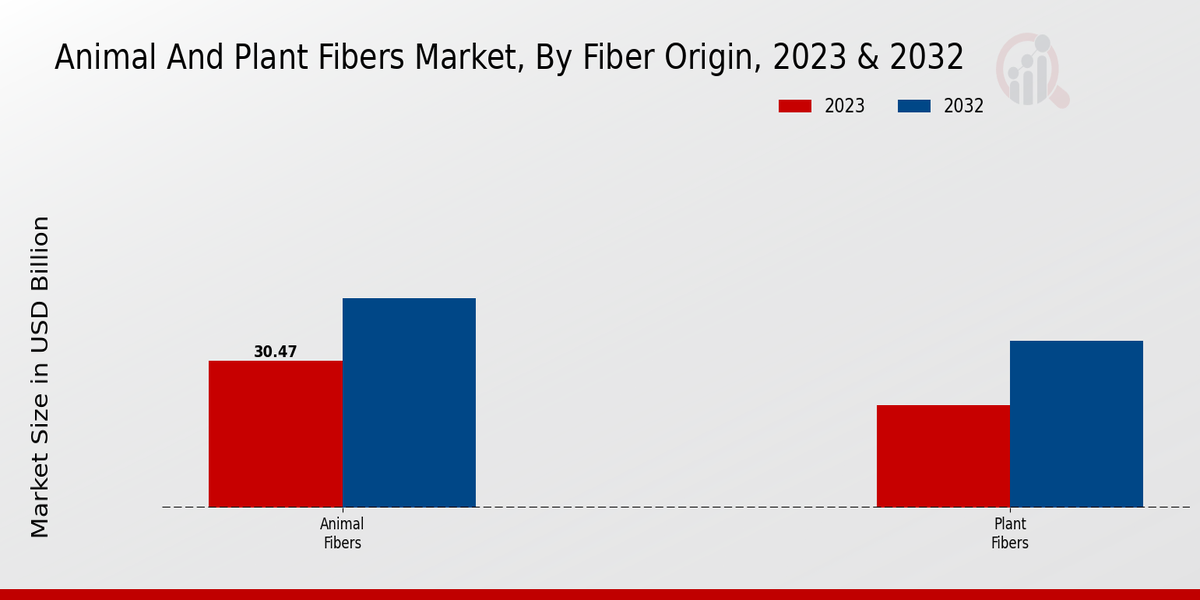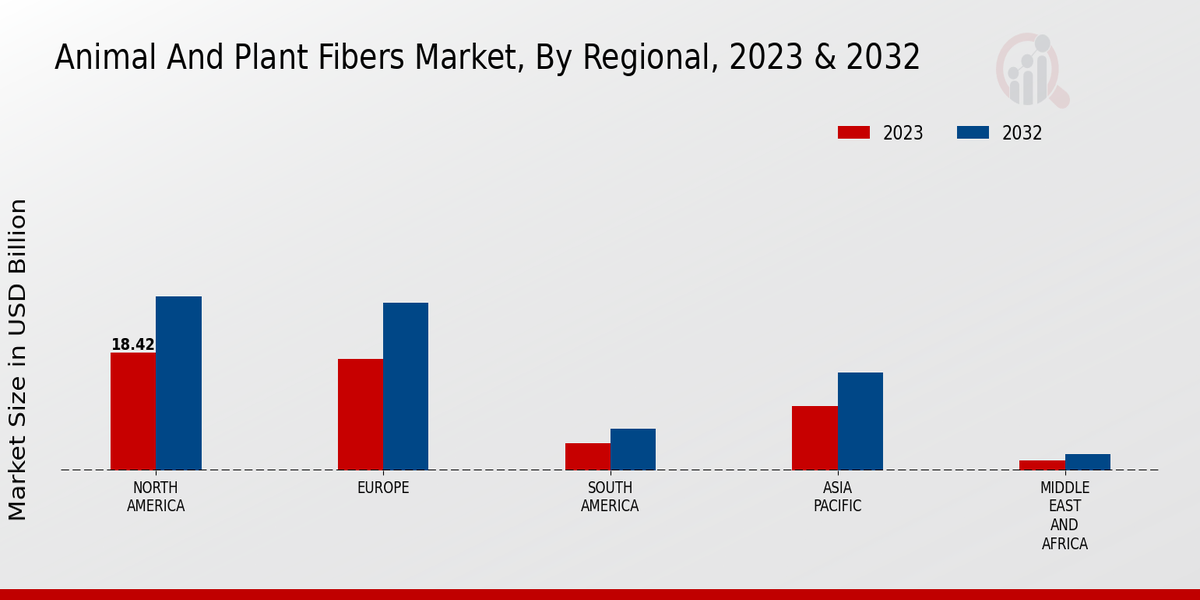Global Animal And Plant Fibers Market Overview
The Animal And Plant Fibers Market Size was estimated at 56.72 (USD Billion) in 2024. The Animal And Plant Fibers Industry is expected to grow from 59.35 (USD Billion) in 2025 to 89.29 (USD Billion) by 2034. The Animal And Plant Fibers Market CAGR (growth rate) is expected to be around 4.6% during the forecast period (2025 - 2034).
Key Animal And Plant Fibers Market Trends Highlighted
Certain major influences pinch the growth of the worldwide Animal and Plant Fibers market especially including a rise in the demand for eco-friendly and sustainable materials, developments in technology used in textile production, and consumers’ concern on the ethical treatment of animals. The market also finds impetus in the growing trend of veganism and cruelty-free products, which in turn boosts the consumption of more plant fibers like cotton, bamboo, and hemp. Besides these, the animal and plant fibers market growth has also been accelerated due to the increasing usage of natural and renewable materials in the fashion industry.

Source: Primary Research, Secondary Research, MRFR Database and Analyst Review
Animal And Plant Fibers Market Drivers
Rising Demand for Sustainable Textiles
The textile sector is shifting its focus towards sustainable production, and in turn, there has been a rise in the use of natural and biodegradable fibers. Natural and synthetic fibers can take care of a good amount of synthetic fibers, which are non-biodegradable, as they are produced from human-made, non-renewable materials. Some of the animal fibers include wool and silk, which are generally bio-degradable. Some of them are cotton, linen and jute, which are also biodegradable, though it is less harmful to the earth as compared to synthetic fibers.
The increasing concern for environmental issues within society will definitely positively influence the consumption of plant and animal fiber-based textiles and theaters. All these factors are propelling the growth of the Animal And Plant Fibers Market Industry.
Growing Health and Wellness Trend
The growing health and wellness trend is driving demand for natural and organic products, including textiles made from animal and plant fibers. Consumers are increasingly seeking products that are gentle on their skin and free from harmful chemicals. Animal fibers, such as wool and silk, are naturally hypoallergenic and have thermoregulating properties, making them ideal for use in clothing, bedding, and other home textiles. Similarly, plant fibers, such as cotton and linen, are breathable and absorbent, making them suitable for use in clothing, towels, and other products that come into direct contact with the skin.The growing demand for natural and organic products is expected to boost the growth of the Animal And Plant Fibers Market Industry.
Technological Advancements and Innovation
There is a shift in how animal and plant fibers are produced and processed due to technological advancements and innovation. High-performance fibers have been developed using new technologies, which have enhanced proper and excellent quality properties, such as processing, strength, duration, moisture management, and insulation. For example, there have been developed wrinkle-resistant and machine-washable wool products due to advancements in the processing of wool and other fibers.Moreover, through technological advancement such as cotton genetical modification, there have been developed a better variety of cotton with high yields and fiber quality. Animal and plant fibers are set to be competitive in the Animal And Plant Fibers Market Industry due to these technological advancements.
Animal And Plant Fibers Market Segment Insights:
Animal And Plant Fibers Market Fiber Origin Insights
Fiber Origin Segment The Animal And Plant Fibers Market is segmented based on fiber origin into animal fibers and plant fibers. Animal fibers are derived from animals, such as sheep, goats, and rabbits, and include wool, cashmere, mohair, and alpaca. Plant fibers are derived from plants such as cotton, linen, hemp, and jute. In 2023, the animal fibers segment accounted for a larger share of the Animal And Plant Fibers Market revenue compared to the plant fibers segment. This is due to the higher demand for animal fibers in the textile industry, as they offer superior properties such as warmth, softness, and durability.Wool is the most widely used animal fiber, accounting for a significant portion of the segment's revenue. The plant fibers segment is expected to witness significant growth over the forecast period, owing to increasing demand for sustainable and eco-friendly materials in various industries. Cotton is the dominant plant fiber, with a wide range of applications in the textile, apparel, and home furnishing industries. Key factors driving the growth of the animal fibers segment include rising disposable incomes, increasing demand for luxury products, and growing awareness of the benefits of natural fibers.The growth of the plant fibers segment is attributed to factors such as increasing environmental concerns, rising demand for biodegradable materials, and technological advancements in fiber processing. Overall, the Animal And Plant Fibers Market is expected to witness steady growth over the coming years, driven by increasing demand from various end-use industries and growing consumer preference for sustainable and natural materials.

Source: Primary Research, Secondary Research, MRFR Database and Analyst Review
Animal And Plant Fibers Market Animal Fiber Type Insights
The Animal Fiber Type segment of the Animal And Plant Fibers Market is expected to witness steady growth in the coming years. Wool, a key animal fiber, is projected to account for a significant share of the market, driven by its versatility and wide range of applications in textiles, apparel, and home furnishings. Mohair, known for its luxurious texture and durability, is also expected to contribute to the market's growth, particularly in the premium fashion segment. Cashmere, renowned for its softness and warmth, is anticipated to remain a niche but high-value segment, catering to discerning consumers.Alpaca fiber, with its hypoallergenic properties, is gaining popularity in the eco-conscious textile industry. Angora fiber, obtained from Angora rabbits, is prized for its unique softness and is expected to witness moderate growth in the market. The Animal And Plant Fibers Market segmentation provides valuable insights into the industry's dynamics, enabling stakeholders to make informed decisions and capitalize on growth opportunities.
Animal And Plant Fibers Market Plant Fiber Type Insights
Cotton held the largest share in 2023, contributing to over 45% of the Animal And Plant Fibers Market revenue. The growth of the cotton segment can be attributed to its wide range of applications in various industries, including textiles, apparel, and home furnishings. The increasing demand for sustainable and eco-friendly materials is further driving the growth of the cotton segment. The flax segment is projected to witness significant growth during the forecast period, owing to its increasing use in the production of linen and other high-value fabrics.The hemp segment is also expected to grow steadily over the coming years, driven by its potential applications in the automotive, construction, and healthcare industries. Jute and sisal are two other important plant fibers used in the production of ropes, twines, and other products.
Animal And Plant Fibers Market Application Insights
Textiles, Nonwovens, Composites, Paper, and Bioplastics are the key application segments dominating the Animal And Plant Fibers Market landscape. Textiles accounted for the largest revenue share in 2023, owing to the extensive use of animal and plant fibers in the production of clothing, home furnishing, and technical textiles. Nonwovens, widely employed in hygiene products, filtration, and medical applications, are projected to exhibit significant growth. Composites, reinforced with animal and plant fibers, offer enhanced strength and lightweight properties, driving their demand in the automotive, aerospace, and construction industries.Paper, derived from plant fibers, continues to be a crucial application segment due to its versatility in packaging, printing, and writing. Bioplastics, made from plant-based materials, gain traction as sustainable alternatives to conventional plastics, fueling market growth. The Animal And Plant Fibers Market segmentation provides valuable insights into the industry dynamics and enables stakeholders to identify opportunities for market expansion and competitive advantage.
Animal And Plant Fibers Market End-Use Industry Insights
The end-use industry segment plays a crucial role in shaping the Animal And Plant Fibers Market landscape, influencing market growth and dynamics. The 'Clothing' segment is projected to dominate the market, accounting for a significant share due to the rising demand for sustainable and eco-friendly fashion. The 'Home Furnishings' segment is anticipated to witness steady growth, driven by the increasing preference for natural and organic materials in interior design. The 'Industrial' segment holds substantial potential, with applications in filtration, insulation, and composites.The 'Medical' segment is expected to grow at a moderate pace, driven by advancements in wound care and regenerative medicine. The 'Automotive' segment presents opportunities for sustainable and lightweight materials in vehicle interiors and components. Overall, the segmentation of the Animal And Plant Fibers Market provides valuable insights into the diverse applications and growth potential of these natural materials in various industries.
Animal And Plant Fibers Market Regional Insights
The regional segmentation of the Animal And Plant Fibers Market offers insights into the market's geographic distribution and performance. North America holds a significant market share, driven by increasing demand for animal and plant-based products in the region. Europe follows closely, with a strong focus on sustainable and eco-friendly fibers. The APAC region is projected to witness substantial growth owing to rising disposable incomes and changing consumer preferences. South America and MEA are emerging markets with promising opportunities for animal and plant fiber manufacturers.This growth is attributed to factors such as increasing awareness of the benefits of animal and plant fibers, rising demand for sustainable materials, and technological advancements in fiber production.

Source: Primary Research, Secondary Research, MRFR Database and Analyst Review
Animal And Plant Fibers Market Key Players And Competitive Insights:
Major players in the Animal And Plant Fibers Market industry are constantly striving to gain a competitive advantage by investing in research and development, expanding their product portfolios, and forming strategic partnerships. Leading Animal And Plant Fibers Market players are focusing on developing innovative products that cater to the evolving needs of customers. Animal And Plant Fibers Market development is also driven by the increasing demand for sustainable and eco-friendly fibers. The competitive landscape is expected to remain dynamic, with new entrants and established players vying for market share.A leading company in the Animal And Plant Fibers Market is Lenzing AG. The company is known for its production of high-quality cellulose fibers, such as Tencel and Lenzing Modal. Lenzing AG has a strong global presence and supplies its products to a wide range of industries, including textiles, nonwovens, and hygiene. The company is committed to sustainability and operates its production facilities in an environmentally responsible manner. Lenzing AG is investing in research and development to further improve the performance and functionality of its fibers.A competitor company in the Animal And Plant Fibers Market is Eastman Chemical Company. The company produces a range of cellulose fibers, including acetate and triacetate. Eastman Chemical Company has a strong presence in the United States and Europe and supplies its products to various industries. The company is focused on developing innovative fibers that meet the specific needs of its customers. Eastman Chemical Company is also committed to sustainability and is investing in research to reduce the environmental impact of its production processes.
Key Companies in the Animal And Plant Fibers Market Include:
- Birla Cellulose
- Sateri Holdings Limited
- Lenzing Group
- Jilin Chemical Fiber Group
- Shandong Ruyi Technology Group
- Teijin Limited
- Fiber Innovation Technology
- Kelheim Fibres GmbH
- SWM International
- Indorama Ventures
- Hengli Group
- Fulida Group
- Rayonier Advanced Materials
- Asahi Kasei Corporation
Animal And Plant Fibers Market Industry Developments
The growth can be attributed to increasing demand for eco-friendly and sustainable materials in various industries, such as textiles, paper, and packaging. Moreover, rising consumer awareness about the environmental impact of synthetic fibers is driving the demand for natural and biodegradable alternatives. Key market players are focusing on research and development to enhance the properties and applications of animal and plant fibers, further propelling market expansion. Recent developments include collaborations between research institutions and industry leaders to explore innovative applications of these fibers in advanced materials and composites.
Animal And Plant Fibers Market Segmentation Insights
- Animal And Plant Fibers Market Fiber Origin Outlook
- Animal Fibers
- Plant Fibers
- Animal And Plant Fibers Market Animal Fiber Type Outlook
- Wool
- Mohair
- Cashmere
- Alpaca
- Angora
- Animal And Plant Fibers Market Plant Fiber Type Outlook
- Cotton
- Flax
- Hemp
- Jute
- Sisal
- Animal And Plant Fibers Market Application Outlook
- Textiles
- Nonwovens
- Composites
- Paper
- Bioplastics
- Animal And Plant Fibers Market End-Use Industry Outlook
- Clothing
- Home Furnishings
- Industrial
- Medical
- Automotive
- Animal And Plant Fibers Market Regional Outlook
- North America
- Europe
- South America
- Asia Pacific
- Middle East and Africa
| Report Attribute/Metric |
Details |
| Market Size 2024 |
56.72 (USD Billion) |
| Market Size 2025 |
59.35 (USD Billion) |
| Market Size 2034 |
89.29 (USD Billion) |
| Compound Annual Growth Rate (CAGR) |
4.6% (2025 - 2034) |
| Report Coverage |
Revenue Forecast, Competitive Landscape, Growth Factors, and Trends |
| Base Year |
2024 |
| Market Forecast Period |
2025 - 2034 |
| Historical Data |
2020 - 2024 |
| Market Forecast Units |
USD Billion |
| Key Companies Profiled |
Birla Cellulose, Sateri Holdings Limited, Lenzing Group, Jilin Chemical Fiber Group, Shandong Ruyi Technology Group, Teijin Limited, Fiber Innovation Technology, Kelheim Fibres GmbH, SWM International, Indorama Ventures, Hengli Group, Fulida Group, Rayonier Advanced Materials, Asahi Kasei Corporation |
| Segments Covered |
Fiber Origin, Animal Fiber Type, Plant Fiber Type, Application, End-Use Industry, Regional |
| Key Market Opportunities |
Sustained growth in textiles and apparel Expansion in the nonwoven industry Growing demand for sustainable and biodegradable materials Increasing awareness of animal welfare Technological advancements in fiber production and processing. |
| Key Market Dynamics |
Rising consumer demand, technological advancements, growing population, increasing disposable income and favorable government policies |
| Countries Covered |
North America, Europe, APAC, South America, MEA |
Frequently Asked Questions (FAQ) :
The Animal And Plant Fibers Market is anticipated to reach a value of approximately USD 59.35 billion in 2025.
The Animal And Plant Fibers Market is projected to exhibit a CAGR of 4.6% from 2025 to 2034.
North America is expected to account for the largest market share in the Animal And Plant Fibers Market in 2025.
Animal and plant fibers find applications in various industries, including textiles, papermaking, food, and construction.
Some of the key competitors in the Animal And Plant Fibers Market include The LYCRA Company, Invista, and Lenzing AG.
Increasing demand for sustainable and biodegradable materials, growing population, and rising disposable income are major factors driving the growth of the Animal And Plant Fibers Market.
Fluctuating raw material prices, intense competition, and stringent environmental regulations are major challenges faced by the Animal And Plant Fibers Market.
Sustainability, innovation, and technological advancements are key trends shaping the Animal And Plant Fibers Market.
The Animal And Plant Fibers Market is projected to reach a value of approximately USD 89.29 billion by 2034.
Growing demand for eco-friendly products, increasing investments in research and development, and emerging applications present potential opportunities for growth in the Animal And Plant Fibers Market.

















